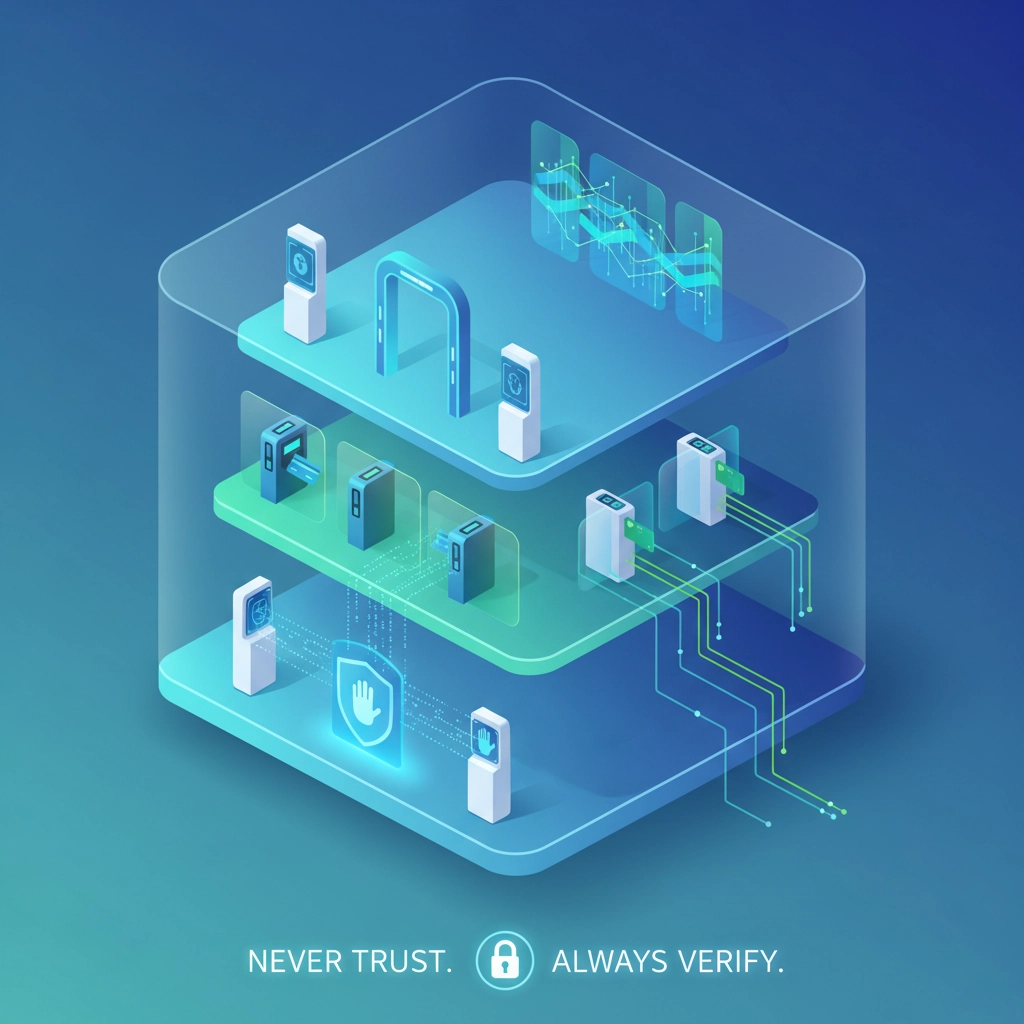Look, I get it. You've heard about Zero Trust security, and it sounds like something only Fortune 500 companies with massive IT budgets can pull off. The truth? That's complete nonsense.
Zero Trust isn't about buying the latest expensive security platform or hiring a team of cybersecurity experts. It's about changing how you think about security: and you can start building serious protection today without breaking the bank.
What Zero Trust Actually Means (No Jargon, Promise)
Zero Trust boils down to one simple rule: "Never trust, always verify." Instead of assuming everything inside your network is safe, you treat every login attempt, file access, and data request like it could be a threat.
Think about it like this: Traditional security is like having a bouncer at the front door of a club. Once someone's inside, they can go anywhere. Zero Trust is like having security checkpoints throughout the entire building: even if someone gets in, they still need to prove they belong wherever they're trying to go.
The best part? This isn't a product you buy off the shelf. It's a mindset you can start implementing right now with tools you probably already have.

Start Here: The Freebies That Pack a Punch
Multi-Factor Authentication (MFA) – Your Secret Weapon
Here's a stat that should get your attention: 99.9% of compromised accounts are missing multi-factor authentication. That means adding MFA to your accounts is like buying a lottery ticket with a 99.9% chance of winning.
The good news? Most MFA solutions are completely free for small businesses:
- Microsoft Authenticator (free)
- Google Authenticator (free)
- Duo (free for up to 10 users)
Set this up on everything: your email, cloud storage, accounting software, social media accounts. It takes about 10 minutes per account and stops most attacks dead in their tracks.
The "Need-to-Know" Rule
Remember when your mom said, "Just because you can doesn't mean you should"? That's the principle of least privilege in a nutshell.
Go through your team's access permissions right now. Does Sarah from accounting really need access to your customer database? Can the new intern see everyone's salary information?
This costs you nothing but time, and it's incredibly effective. If a hacker gets into one account, they can only mess with what that person actually needs for their job.
Policy First, Technology Second

Before you start shopping for security tools, write down your rules. This might sound boring, but it's the foundation everything else builds on.
Create simple policies that answer:
- Who can access what data?
- When can they access it? (Business hours only? Anytime?)
- From where? (Office only? Home office? Coffee shop?)
- What happens when someone leaves the company?
These don't need to be 50-page documents. A simple one-page sheet for each area works great. The key is having something written down so everyone knows the expectations.
Segment Your Data Like It's Top Secret
Data segmentation sounds fancy, but it's really just organizing your stuff better. Instead of keeping everything in one big bucket, create separate areas for different types of information.
For example:
- Customer data in one folder/system
- Financial records in another
- Employee information somewhere else
- Day-to-day working files separate from all of the above
Most cloud storage services let you set up different permission levels for different folders. Use them. If someone breaks into one area, they can't automatically access everything else.
Open Source: Your Budget's Best Friend
The cybersecurity world has some incredibly powerful free tools that can rival expensive enterprise solutions. While you'll need some technical know-how to set them up, the savings can be substantial.
Look into open-source solutions for:
- Identity management
- Network monitoring
- Access control
- Security information and event management (SIEM)
Even if you eventually hire someone to help implement these, you're still looking at a fraction of the cost of commercial alternatives.

Train Your Team Without Breaking the Bank
Your employees are your biggest security asset: or your biggest vulnerability. The difference comes down to training.
You don't need expensive cybersecurity courses. Start with these free resources:
- YouTube has thousands of cybersecurity awareness videos
- Government websites offer free training materials
- Many cybersecurity companies provide free basic training
Make it a monthly team meeting topic. Show real examples of phishing emails, talk about safe browsing habits, and explain why these security measures matter.
Think Like a Hacker (Legally)
Instead of paying for expensive penetration testing, get your team to think like hackers. How would someone try to break into your systems?
Try these exercises:
- Send fake phishing emails to your team (let them know it's a test afterward)
- Try to guess each other's passwords
- Look for USB drives lying around the office
- Check if people are leaving their computers unlocked
This costs nothing but time and can reveal surprising vulnerabilities.
The Phase-by-Phase Approach
Don't try to implement everything at once. You'll overwhelm yourself and probably mess something up. Instead, work in phases:
Phase 1: The Quick Wins (Week 1-2)
- Enable MFA on all critical accounts
- Review and tighten access permissions
- Create basic security policies
Phase 2: Data Organization (Month 1)
- Segment your data properly
- Set up proper backup systems
- Document who has access to what
Phase 3: Monitoring and Training (Month 2-3)
- Implement basic monitoring tools
- Start regular security training
- Test your backup and recovery processes
Phase 4: Advanced Measures (Month 4+)
- Add more sophisticated monitoring
- Implement additional security tools as budget allows
- Regular security assessments

When to Call in the Experts
Sometimes the smartest budget move is knowing when you're in over your head. Consider working with a cybersecurity provider when:
- You're dealing with sensitive customer data (healthcare, finance, legal)
- Your business is growing and systems are getting complex
- You've had a close call or actual security incident
- You need to meet specific compliance requirements
A good cybersecurity partner can help you implement Zero Trust principles more efficiently and avoid costly mistakes. As we've discussed before, working with a smaller, specialized provider often gives you better value and more personalized attention than the big corporate players.
The Reality Check
Let's be honest: Zero Trust on a shoestring budget isn't about having perfect security overnight. It's about being significantly better protected than you are today while building toward even stronger security tomorrow.
Even basic Zero Trust principles: like MFA, proper access controls, and data segmentation: will put you ahead of 80% of small businesses. The hackers are looking for easy targets. Don't be one.
Your Next Move
Zero Trust security doesn't require a Silicon Valley budget or a team of cybersecurity experts. It requires a commitment to doing things differently and the willingness to start with what you have.
Pick one thing from this list and implement it this week. Then pick another thing next week. Before you know it, you'll have built a security framework that would make much larger companies jealous.
Ready to stop hoping nothing bad happens and start building real protection? Get in touch with us to discuss how we can help you implement Zero Trust security that fits your budget and actually makes sense for your business. Because your data is worth protecting, even if your security budget isn't Fortune 500-sized.




































































































